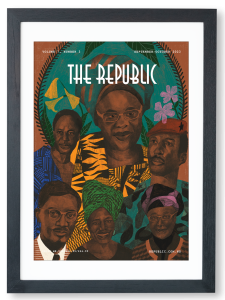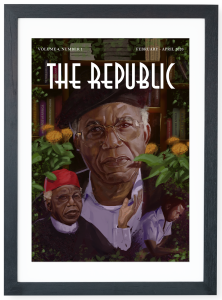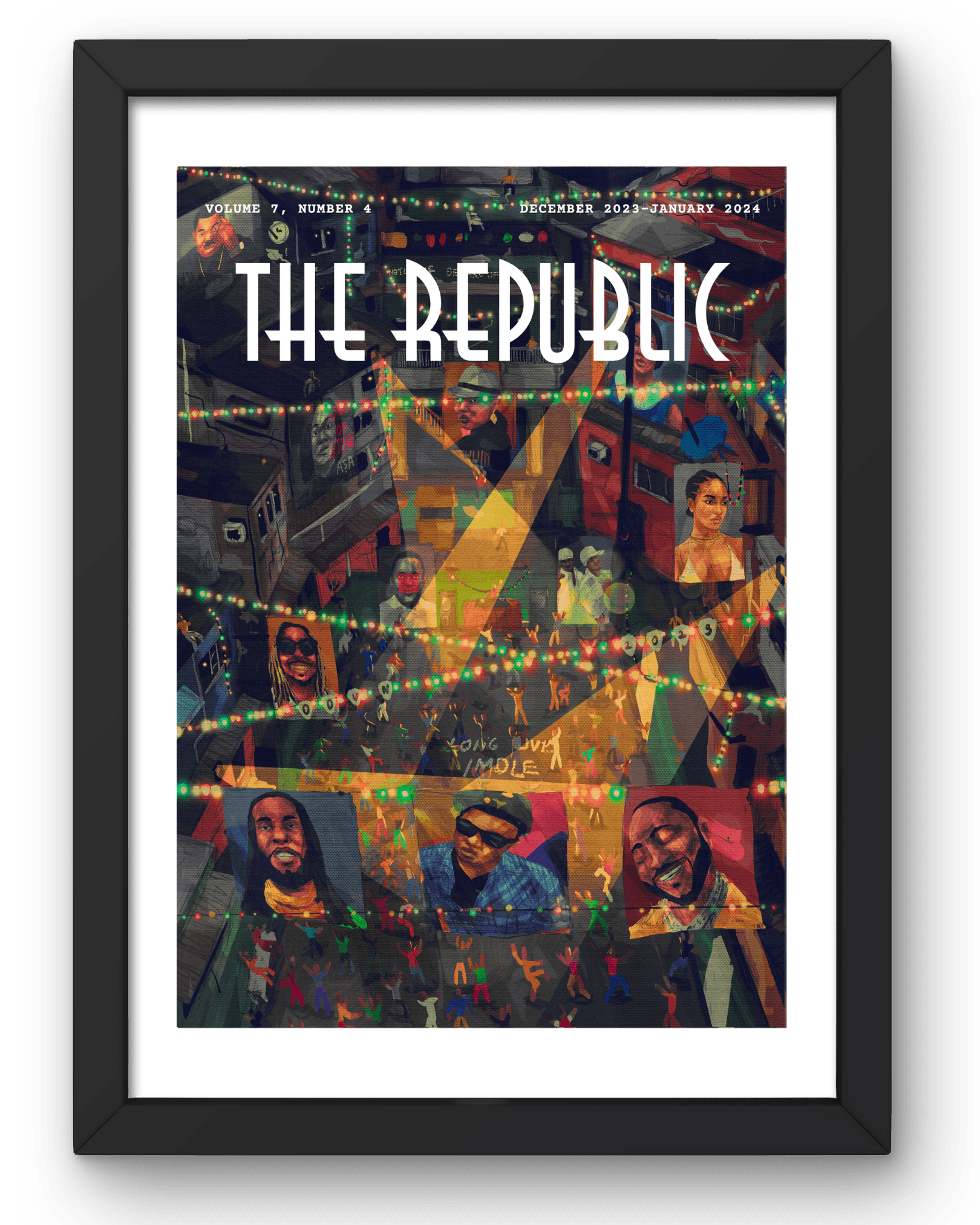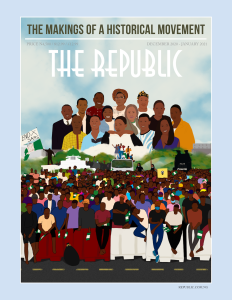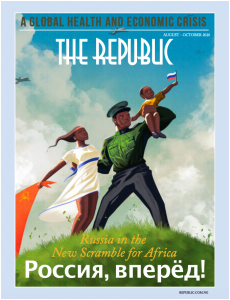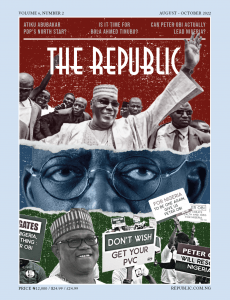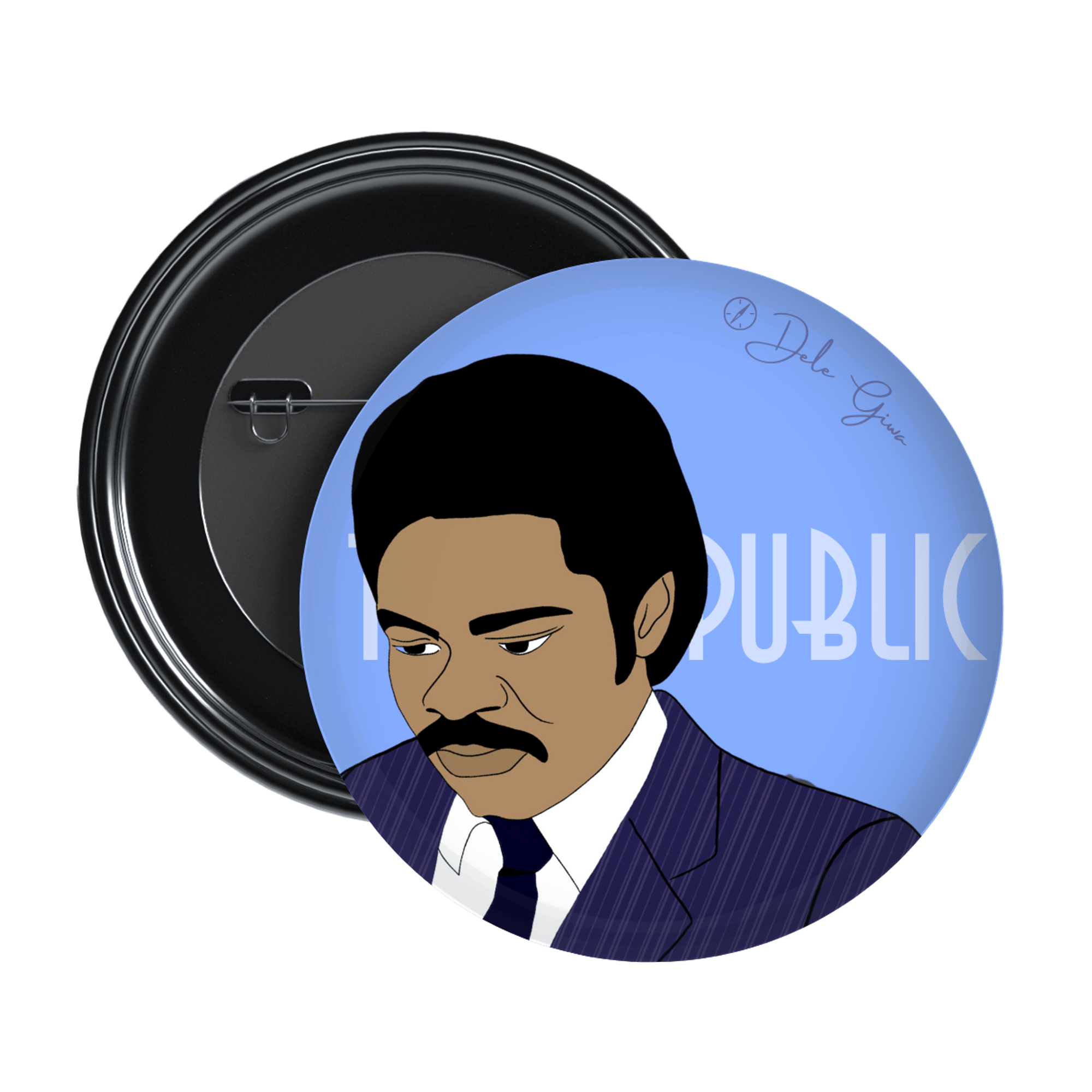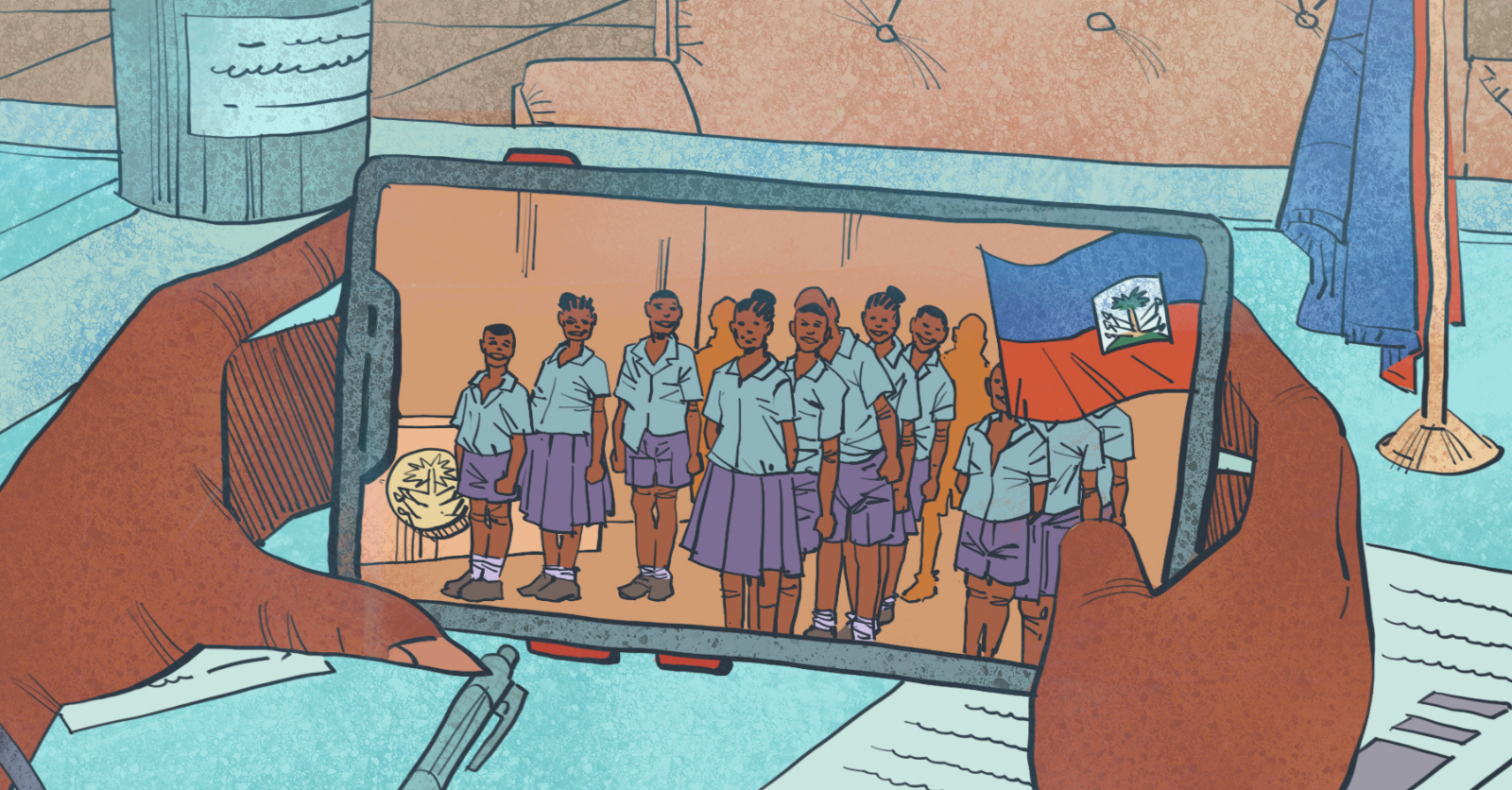
Illustration by Charles Owen (blvninjv).
DISPATCH FROM HAITI
‘Pour le Pays, Pour la Patrie, Mourir est Beau’

Illustration by Charles Owen (blvninjv).
DISPATCH FROM HAITI
‘Pour le Pays, Pour la Patrie, Mourir est Beau’
Support for this essay came from the Open Society Foundations Ideas Workshop.
Pour le Pays, pour la Patrie mourir est beau.’ A lot of my early memories are centred around this sentence. At the stroke of 8:00 a.m. each morning, for the most of 20 years, the bell of my school would ring, ushering a collective silence. Countless other students and I across Haiti would pour our hearts into song, eyes fixed on the flag as it unfurled its grandeur against the Haitian sun. Initially, these moments were merely a daily routine, our voices echoing lyrics we scarcely grasped. But as I aged, so did my understanding. The words grew heavy with significance and history—one that spoke of liberation and evoked inspiration. The flag, embodying unity, agricultural richness, and sovereignty was more than just a symbol; it was a statement that life for ‘my country, my homeland’ was worth sacrificing. There was a flag, a symbol of unity of a history that is (was?) worth proclaiming, ‘Pour mon pays, pour ma patrie mourir est beau.’ We declared it with all the innocence in the world, honouring a flag that stood for more than territory but as a testament to the resilience of history.
The more I reflect on our national anthem, the ‘Dessalinienne’, the more I find the irony in the descent into madness Haiti is currently experiencing. Composed in 1903, the Dessalinienne was a centennial tribute to our independence, a remembrance of Jean Jacques Dessalines, the first Haitian emperor. Yes, the Haiti you see now in the media was once an empire, a success story of the enslaved Africans stolen from their land. Why am I bringing you this far? Well, I think it’s essential to see this country in all that is not shown or talked about enough. I am inciting the question of what happened. How did a country that once held an empire comparable to the European monarchies in its richness and grandeur fall under the plight of gang rules, deprived of its sovereignty? How did an anthem I once understood to foresee a brighter destiny for Haiti come to seem like a cruel paradox for those who believed in it?
‘POUR LE PAYS, POUR LES ANCÊTRES, MARCHONS UNIS, MARCHONS UNIS. DANS NOS RANGS POINT DE TRAÎTRES DU SOL SOYONS SEULS MAÎTRES.’
‘For the country, for our ancestors, united we walk, no traitors in our ranks, of our soil, we alone are masters.’
Since its independence from France in 1804, Haiti has struggled to establish itself as the free country it fought to be. After 1804, Haiti had to pay France 112 million francs, about 600 million dollars now, to recognize its independence. Being a small country, Haiti had to borrow this money from the French at interest; it took the country 122 years to repay this debt. Money that could have gone to any fundamental institution for the country’s development. Yet the new free Black Haitians chose freedom and sovereignty, and France remained in a position of power over Haiti’s trade and economy. But Haiti’s independence was also not welcomed by the newly independent American republic, which thrived on the back of slavery. Fearing Haiti’s independence might fuel a slave insurrection in the American South, the United States imposed a 65-year embargo on Haiti, which it only lifted after the abolition of slavery in 1865. By 1868, the US began to see Haiti and the Dominican Republic as a naval base to secure US defence and economic interests. They were unsuccessful. By 1915, President Woodrow Wilson decided to send US Marines to Haiti, supposedly to establish stability in the regions. The marines, however, brought with them all the racism and segregation of the Jim Crow era.
By 1917, the US government took it upon themselves to dissolve the Haitian parliament because of the parliament’s refusal to approve a new constitution prepared by the US State Department allowing for land ownership, outlawed with the Haitian Revolution. US occupation lasted until 1934, when the marines left Haiti, taking with them Haiti’s gold reserves, historical documents, and pride of sovereignty.
The narrative unfolds from then to the 1991 coup, a period where Haitian democracy struggled to succeed, leading to a series of coups and subsequent instability. In September 1991, a military coup led by Lieutenant General Raoul Cedras overthrew President Jean Bertrand Aristide. The international community’s response was to impose an embargo on Haitian food and medicine. In 1992, Bill Clinton’s administration secured a United Nations Security Council resolution allowing for the first time use of force to restore democracy in a foreign state under the slogan ‘Upholding Democracy’. Haiti was seen as a playground where the international community could try something new, a region classified as unique and extenuating. In September 1994, US military aircrafts and 25,000 US military personnel arrived in the capital, Port-au-Prince. This occupation lasted two years, taking with it Haiti’s military, the remanence of a democratic system, and, again, the pride of sovereignty.
A little over a decade later, by June 2004, Haiti was still struggling socio-politically. In response to the political unrest and social turmoil, the UN Security Council established the United Nations Stabilization Mission in Haiti (MINUSTAH), again under the guise of a stabilization force wanting to help Haiti have ‘fair elections’. This pseudo-occupation lasted until 2014. During this time, there were multiple reports of rapes and assaults on women and children. The deadliest cholera outbreak of the 21st century was traced back to Nepalese peacekeepers in the Haitian Central Plateau, which holds of the primary water sources of the region, and was contaminated with wastewater. The water contamination meant a bigger strain on Haiti’s healthcare system. To this day Haiti’s healthcare infrastructure has struggled to recover. In 2016, the UN deemed a formal apology enough to compensate the victims. This time, when the forces left, they took with them the innocence of children, victims of their assaults, and from the women who held together the society, leaving behind children who would struggle with their identity based the heritage of their birth.
Now, on the cusp of 2024, as we contemplate the potential return of a UN force, the cycle appears set to repeat. The lingering question haunts: What will be taken this time, or what is there left to take? Haiti’s struggle against this modern form of neo-colonization is not just a battle for land or governance but a fight to vindicate the vision of our revolutionaries. The ancestors of Haitian independence understood the need to keep this land sovereign and free, maybe foreshadowing the disaster that could be if those principles are abandoned… by will or by force?
shop the republic
‘POUR LES AÏEUX, POUR LA PATRIE, BÊCHONS JOYEUX, BÊCHONS JOYEUX. QUAND LE CHAMP FRUCTIFIE, L’ÂME SE FORTIFIE.’
‘For our ancestors, for the Nation, let us till with joy. As the harvest flourishes, our spirit strengthens.’
This verse, a lyrical embodiment of hope and perseverance, resonates with deep-seated pain in the current Haitian consciousness. It speaks to an inherent connection between the land and the soul of its people—a bond once fertile and sustaining. Yet, in 2024, the stark reality of food insecurity looms large over Haiti. Recent data reveals a harrowing forecast: 4.97 million Haitians, 91 per cent of the population studied, are projected to face severe hunger, with children making up a heartbreakingly significant proportion. The land that once enriched colonial powers, nurtured the luxury of Europe, and was formerly celebrated as the ‘Pearl of the Antilles’, now struggles to nourish its children. The irony is as profound as it is tragic—what has befallen the agricultural heritage that once sustained empires?
The embargo of 1991 by the OAS was associated with the loss of over 2,000 jobs in Haiti. There was a significant rise in the price of imports. By 1994, a gallon of gasoline was $10 from previous years’ $5 in the Haitian capital, which crippled the distribution of agricultural products and essential goods into Port-au-Prince and the rest of the county. The embargo affected agricultural inputs by limiting seeds and fertilizers, accelerating a long-term trend of agricultural decline. The production of staple crops fell by more than 20 per cent. From 1991 to 1994, the price of rice increased by 137 per cent.
In 1995, President Clinton pressured Haiti to lower its tariffs on rice imported from America, from 50 percent to 3 percent. The reduction of tariffs, purportedly a step towards industrial progress, tethered Haiti to American rice, undermining Haiti’s agricultural base. After adopting the policy, Haiti became the fourth-largest importer of rice from the US, and most of this imported rice was linked to President Clinton’s home state in Arkansas. Today, Haiti is the fifth largest importer of American rice in the world, even though Haiti’s primary source of agriculture and production has been rice from its discovery in 1492; and, without being biased, even though Haiti probably produces some of the best rice I’ve ever tasted. One tonne of Haitian rice is $300 more expensive than American rice in the Haitian Market.
Back in the 1970s, under the dictatorship of President Jean Claude Duvalier, Haiti imported only 19 per cent of its food. When Haiti shut out the global markets, it was self-sufficient and managed to feed most of its population while producing trade surpluses. Today, however, Haiti imports over 80 per cent of its rice from the US, devastating Haiti’s ability to feed itself and be self-sufficient. Haiti has 700,000 hectares of underutilized arable land but still suffers from chronic trade deficits and food insecurity due to Clinton’s policies. In 2011, President Clinton seemingly apologized for America’s role in destroying the rice production in Haiti. ‘It was a mistake,’ he said. On February 21, 2024, the University of Michigan released a report claiming that the rice exported to Haiti from the US contains unhealthy levels of arsenic and cadmium, which could lead to a high risk of cancer and diabetes. Is the apology enough to remedy this?
In 2010, Haiti suffered the infamous earthquake that killed over 200,000 people, one of them being my younger brother, and displaced millions, causing a collective trauma that is impossible to describe. Before the earthquake, the international community had made itself at home in Haiti, with upward of 10,000 NGOs operating in the country; the number of NGOs in Haiti has since soared, reaching as many as 30,000 organizations. Multiple reports highlight that the international community mobilized up to $8 billion into various development projects in Haiti. Were there any plans allocated to rebuilding the agricultural infrastructure? Everyone wants to provide, or sell the fish, but they have yet to plan to teach local communities to fish, to help those communities sustain themselves; to depend more on their strength in agriculture and their land.
In 2023, the determined citizens of Haiti’s north-eastern regions embarked on a critical irrigation endeavour, channelling the waters of the historically significant Massacre River to revive over 7,000 acres of arable land. This initiative, rooted in the pursuit of agricultural self-sufficiency and empowerment, was starkly opposed by the Dominican Republic. Citing a breach of the 1929 treaty, the Dominican Republic’s President Luis Abinader closed air and sea borders, seeking to halt the canal’s construction. Despite the diplomatic fray, Haitian scholars staunchly maintain that the treaty envisages equitable water access for both nations.
The ensuing conflict raises questions about the motives behind the Dominican Republic’s stringent stance. Could this be perceived as another attempt to maintain Haiti’s reliance on imported goods, perpetuating a cycle of dependency? Conversely, the canal project, evocative of the unity and resolve heralded in Haiti’s national anthem, has sparked a wave of solidarity among Haitians. The rallying cry ‘Kanal la pap kanpe’ (The canal will not stop) has resonated across the country, galvanizing citizens to stand firm in their rights to land sovereignty and their rights to harness the life-giving resources of their homeland.
shop the republic
‘POUR LE PAYS ET POUR NOS PÈRES FORMONS DES FILS, FORMONS DES FILS. LIBRES, FORTS ET PROSPÈRES TOUJOURS NOUS SERONS FRÈRES, FORMONS DES FILS.’
‘For the country, and for our fathers, let us teach our sons. Free, strong, and prosperous, we will always remain brothers.’
Since the start of this year, due to the rise of gang violence, 900 schools have closed around Port-au-Prince, widening the gap in an already failed and fragmented education system. For a long time, the disparities within the allocation of funds for public institutions were not prioritized, with public schools grappling with outdated curricula and a lack of textbooks, chairs, and desks. as of 2003, 92 per cent of schools were privately funded and charged parents high admission prices. In addition to financial challenges, the Haitian education system faces linguistic barriers. Creole is the most spoken language in Haiti, but most schools teach in French, a language not available to everyone, discriminating against those from different socio-economic backgrounds. As of writing, I learnt that a couple of days ago, Haiti had lost to gang fire one of its oldest institutions, the École Normal Supérieure, which was created in 1947, to educate future secondary school teachers. A few days later the Bibliothèque Nationale d’Haiti, that holds thousands of documents and archives of Haiti’s history was also set ablaze by gang members in their path of destruction. As flames consumed classrooms and libraries, they also incinerated a part of the dreams our ancestors had for us: to value education and understand that it is the way to live free, strong and prosperous lives.
Adding insult to injury, this year, Haiti is also experiencing an alarming exodus. As instability mounts, families, young professionals, medical practitioners, and teachers are compelled to seek safety beyond Haitian borders, signalling a dire brain drain that saps the country of vital human resources. The growing gap in the education system is distressing; it’s been over a year since gangs have taken over and schools are finding it increasingly challenging to keep up with the country’s instability. The fate of Haitian children unable to access remote learning amidst this chaos is especially poignant. They stand at the precipice of an uncertain future, their potential untapped, their right to education unfulfilled.
shop the republic
‘POUR LES AÏEUX, POUR LA PATRIE, O DIEU DES PREUX, O DIEU DES PREUX. SOUS TA GARDE INFINIE PRENDS NOS DROITS, NOTRE VIE, O DIEU DES PREUX.’
‘For the ancestors, for the nation, God of the brave, we call. Under your infinite protection, take our rights and lives, God of the brave.’
220 years since the inception of this prayer, the Haitian people remain in a posture of supplication, beseeching for protection and intervention. The international community, in many respects, has attempted to answer this call—though not always with the wisdom or the unerring grace that the invocation seeks.
The dreams of Haiti’s forefathers—a vision of sovereignty, thriving agriculture, and enlightenment through education—stand at a crossroads, hovering between the lingering shadows of dreams and the dawning light of potential reality. The questions that rise from the ashes of a troubled history are heart-breaking: has the loss of what was so ardently fought for been a deliberate act, a punitive measure against a nation whose only sin was its desire to exist as a free, black, land-owning society?
To see these dreams realized, the Haitian people may need to look through a different lens, one that magnifies their agency and self-reliance, requiring the collective effort to rebuild Haiti from within, harnessing the indomitable spirit of our ancestors to foster a future where education illuminates every mind, and the land once again provides for its children. The international community’s role should evolve from one of saviour to that of a supportive ally, promoting and respecting the resolve of the Haitian people.
As the call ‘Pour les Aïeux, pour la Patrie’ echoes over time, it is not just a cry for salvation but a clarion call for solidarity, dignity and the unwavering pursuit of the rights and freedoms that the forefathers of Haiti envisioned. In safeguarding these dreams, Haiti will honour its past while forging a destiny defined by the bravery, resilience and unity that have been its inheritance.
However, let this not be an elegy for what could have been but a rallying cry for what still can be achieved; it has already been written; the plan was set all along. The sovereignty sought by Haiti’s forebears must be reimagined and reclaimed, not as a relic of the past, but as a living testament to their courage, to be renewed by each successive generation. In the immortal words that call upon the God of the brave, let the Haitian people find solace and the strength to rise, build, educate, and thrive—free and unfettered—beneath the endless sky of their homeland⎈





